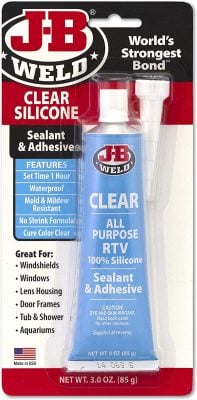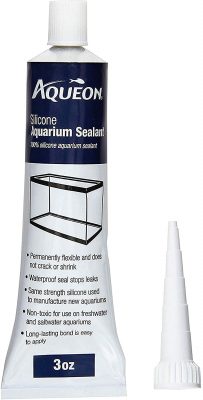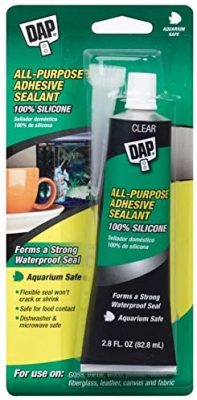The 9 Best Aquarium Silicone Sealants to Buy in 2025
Using the wrong aquarium silicone can kill your fish and other aquatic life. What’s worse is that even silicone marked as ‘aquarium-safe’ can cause serious harm to your tank’s ecosystem if it’s used incorrectly – a reality that many fishkeepers discover too late. Even if you manage to avoid any fishy fatalities, the best-case scenario is still a nightmare: re-cycling your tank and rehoming your fish until the pH levels rebalance and there’s no risk of toxicity.
That said, aquarium silicone should be considered an essential part of every aquarist’s toolkit – from novices to experienced hobbyists, and for marine or tropical set-ups. Why? As well as being the ideal adhesive for emergency leak repairs and for resealing glass cracks, silicone is also incredibly useful for fixing decorations, sealing filter systems, and tank construction.
Unfortunately, most people start their search for aquarium silicone a little too late. In fact, there’s a good chance that right now you’re reading this shortly after spotting your first slow leak. If so, don’t panic. Silicone is the best way to reseal your aquarium glass, and our guide details exactly what to do, how to do it, and which products are best for the job.
So, before that leak gets any worse, let’s dive right into it.
- Factors to Consider When Choosing Aquarium Silicone
- Top 9 Best Aquarium Silicone Sealants 2025
- 1. Best Overall Aquarium Silicone: ASI Aquarium Sealant
- 2. Best Precision Gluing Aquarium Silicone: Loctite Clear Silicone
- 3. Best Premium Aquarium Silicone: J-B Weld Clear Silicone
- 4. Best Leak Sealing Aquarium Silicone: Aqueon Aquarium Sealant
- 5. Best Budget Aquarium Silicone: GE All-Purpose Silicone
- 6. Best Filtration Sealing Aquarium Silicone: Aquascape Black Silicone
- 7. Best Beginner-Friendly Aquarium Silicone: Dap All-Purpose Adhesive Sealant
- 8. Best Ornament Repairing Aquarium Silicone: MarineLand Aquarium Sealant
- 9. Best Professional Tank Building Aquarium Silicone: Momentive RTV108 Silicone
- Guide to Buying the Best Aquarium Silicone
- Aquarium Silicone Frequently Asked Questions
- Aquarium Silicone: Time Is the Cure
Factors to Consider When Choosing Aquarium Silicone
Silicone sealant is a type of adhesive that acts as a stable, elasticated gel. It’s applied as a gelatinous paste, but once left to cure it gradually becomes a hardened sealant. It’s known for its excellent adhesion on glass and exceptional resistance against both environmental influences and aging.
Considering that most aquariums are constructed from glass, subject to constant submersion, and constructed for long-term usage, it’s no surprise that silicone is so beneficial to aquarists. You can read more about the specific advantages in our benefits of aquarium silicone section, but honestly, the decision to buy it is the easy part. Knowing which aquarium silicone to choose is much more complex. Here’s some fish-food for thought:
Aquatic Suitability
Unfortunately, there’s a lot of misinformation and conflicting accounts floating around online, which makes picking an aquarium silicone a daunting task. It’s no surprise that aquarists are cautious – the wrong product can harm your fish, and making the wrong choice here could destroy the aquarium set-up that you’ve spent years building. As such, the first decision you need to make when choosing an aquarium silicone is whether it’s suitable for your tank.
If you’d like a deep-dive on what to look out for, you can skip ahead to our detailed guide on how to spot fish-toxic silicone products. Otherwise, keep reading and relax qith the knowledge that all the products included in our list have been used without issue by serious aquatic hobbyists for many years.
Size
Aquarium silicone is sold in sizes as small as 1 oz, all the way up to 12 oz+. If you already own a sizable tank or expect to upgrade within the next year, it may be cost-efficient to purchase a larger tube and an accompanying caulk gun.
Otherwise, bear in mind that silicone only requires moderate application and does go bad – most products are indicated for use within 12-18 months. Poorly constructed squeeze-tubes can also mean clogged applicator tips and wasted product, so pay attention to sizing and buy with a task in mind.
Color
Your choice is between clear/transparent or black. Silicone can’t be painted over, so you’ll want the color that fits in best with the aesthetic of your aquarium. Notably, clear-colored silicone can discolor over time, taking on a shade of yellow. This is natural and is the result of constant exposure to fluids. Of course, there’s not much you can about the water, but opting for a black silicone can help you sidestep this issue entirely. Just watch-out for lower quality black sealants, as they’re more prone to flaking.
Adhesion
The tensile strength of a silicone refers to the amount of pressure it can handle without compromising. Larger tanks require a greater tensile strength and some products only advise use on tanks under a certain gallon capacity or that are within specific dimensions. Where this is the case, it’s noted in our reviews. Some silicones are better suited for small, quick-fix jobs, whereas others are formulated to connect glass panels or seal large leaks.
Ultimately, the level of adhesion you need depends on your intended use. Our product reviews outline each product’s specific adhesion abilities, but you can also check out our section detailing how to choose the best aquarium silicone for your needs.
Ease of Application
Some products are sold in cartridge-style tubes, which you’ll need your own caulking gun for, but for more refined applications, smaller squeeze-tubes are also available. Each also has a slightly different viscosity and texture.
As such, some aquarium silicones are beginner-friendly and best suited for small ad-hoc jobs. Others require a little more application finesse, but whatever your experience level, we’ve included a detailed guide for how to apply aquarium silicone, so you can’t go wrong.
Cure Time
Unlike glue, silicone takes time to properly set (or cure), which can take anywhere from hours to weeks to complete depending on the product and quantity used. A chemical release takes place during the curing process, and placing in water before it’s fully cured means these chemicals will seep into the water, harming your aquatic life and offering inferior bonding performance.
Once cured, though, silicone adheres very well to surfaces like glass but remains fully resistant to submersion, extreme temperatures and UV light. Generally, the longer a product takes to cure, the stronger the bond it offers – you’ll need to factor in the time you’ve got to spare and how long you’re willing to rehome your fish.
With these factors in mind, it’s time to break down our picks for the best aquarium silicone products available today.
Top 9 Best Aquarium Silicone Sealants 2025
1. Best Overall Aquarium Silicone: ASI Aquarium Sealant

Editor’s Rating:
Why we like it: With incredible bonding on even the largest capacity tanks and a stiff consistency that makes application a breeze, ASI Aquarium Sealant is the best overall aquarium silicone we’ve seen.
Quick Facts:
- Type: Made specifically for aquarium use
- Volume: 10.2 fl oz
- Color: Clear, black
- Cure time: 10 days
Size & Color
Ideal for those with large aquatic set-ups, this sealant is rated for use in tanks up to a whopping 750-gallon capacity. This is the highest capacity rating we’ve seen, and it’s not particularly close, either. It comes in a sizable 10.2 fl oz size bottle, but a caulk gun is necessary for use. You’ll need to factor this into your pricing considerations – but of all the products reviewed, only GE Silicone 1 beats out ASI on $-per-oz value.
ASI’s sealant is available in both transparent and black color variations, the latter being excellent for those wishing to match existing black seals, which are increasingly popular on new, store-bought tanks. Plus, we find the black version is great for hiding algae, and the added colorant isn’t prone to flaking – sometimes an issue with other black silicones.
Adhesion
Simply put, it’s the best multi-use silicone we’ve seen: strong enough to seal glass panels or fix large cracks, without being overkill for use on small chips or decorative repairs. By comparison, most other products can only excel in one area.
We consider this the stand-out choice if you’re looking for silicone to use on multiple tanks, or a do-it-all product to reseal panels as well as fix small issues. Impressively, it also bonds well to acrylic tanks, something most other aquarium silicones simply can’t do. In fact, according to ASI’s in-house testing, this silicone can hold together a 700-gallon acrylic tank without issue.
Ease of Application
ASI’s silicone has a stiffer consistency than most other silicones, which we find makes it ideal for vertical seals because it doesn’t flow away from the application site. This stiff consistency also makes spillages and misapplications much less likely than with more viscous silicones. Plus, it starts to set rapidly, which allows you to work at a fast pace. The trade-off? It’s more likely to stick to your fingers, so we advise wearing a pair of gloves during use.
Cure Time
Although it starts to set quickly, this product takes a long time to fully cure – up to 10 days. This means rehoming your fish for a significant amount of time, and while the quality is worth the wait, it will give off silicone’s characteristic vinegary smell throughout.
Pros
- High tensile strength, suitable for large tanks
- Ideal for multi-use work: great for big and small repair jobs
- Will bond acrylic even on large capacity tanks
- Easy vertical application due to stiff consistency
- Also available with a black colorant
Cons
- Adheres to skin more strongly than competitors
- Long time to cure
2. Best Precision Gluing Aquarium Silicone: Loctite Clear Silicone
![]()
Editor’s Rating:
Why we like it: Loctite Clear is the best precision gluing silicone available today. Plus, the conveniently sized squeeze-tube and rapid cure time make it perfect for beginners looking for a quick, simple solution.
Quick Facts:
- Type: Multi-purpose, aquarium safe
- Volume: 2.7 oz
- Color: Clear
- Cure time: 24 hours
Size & Color
Loctite Clear Silicone is sold in a small, 2.7 oz tube. This may feel tiny, but in our experience, it’s still more than sufficient for those with average-sized aquariums who only need to fix a small leak. Used this way, you’ll still get plenty of use from a tube this size. Notably, it shouldn’t be used to seal aquariums with a water capacity above 30 gallons.
Adhesion
Loctite Clear Silicone does an excellent job of adhering to tank glass, and it’s ideal for those needing a small amount of silicone on hand for emergencies, or for precise gluing of small decorative objects. It’s also a convenient product to have around the home for other DIY work, as it bonds well to stainless steel, wood, porcelain, and fiberglass.
Ease of Application
There’s no caulking gun required here; the simple squeeze-tube makes this very beginner-friendly. Plus, it comes with a removable pinpoint tube head, which is incredible for precise application. Unfortunately, this applicator is prone to clogging after a couple of uses and you may have to resort to application directly from the tube. If so, go light when squeezing, as in our experience these tubes tend to burst rather easily.
Cure Time
This stuff cures very quickly. In our experience 24 hours is all it takes – that’s up to 9 days sooner than with ASI Aquarium Sealant. If you’re looking to quickly repair a minor issue in a small tank, you can’t go wrong here.
Pros
- Excellent for precision gluing
- Small convenient size
- Beginner-friendly
- Fast cure time
Cons
- Tube is prone to bursting
- Not suitable for aquariums over 30 gallons

Editor’s Rating:
Why we like it: JB Weld boasts the quickest silicone cure time available and is the ideal aquarium silicone if you’re willing to pay for convenience.
Quick Facts:
- Type: Multi-purpose, aquarium safe
- Volume: 3 oz
- Color: Clear
- Cure time: 1 hour
Size & Color
JB Weld is a clear-colored silicone that comes in one size – a small, 3 oz tube. While we believe its performance does justify the price, bear in mind that it typically costs in excess of $3 per oz.
WARNING: While JB weld offers silicone in 8 different colors – only the ‘Clear’ version is indicated for aquarium use. All other variations contain additives that can harm aquatic life.
Adhesion
The closest competitor for JB Weld is Loctite Clear Silicone. In terms of adhesion, they’re equally impressive and there’s no noticeable difference in their strength or consistency. As with Loctite, it’s only suitable for smaller repair projects, though.
Ease of Application
JB Weld comes with a removal applicator head, making application beginner-friendly, even for tricky chips or hard to reach interior spots. In our experience, this applicator head is less prone to clogging than Loctite, although the squeeze-tube is equally as likely to split under excessive pressure.
Cure Time
JB weld only takes a single hour to cure, faster than any other product we’ve seen. This curing speed offered is phenomenal and perfect for making a small seal fix in a pinch. This benefit should not be underrated and means you won’t need to find a longer-term solution for rehoming your fish, and can get your normal set-up back together in a single afternoon.
Pros
- Beginner-friendly squeeze-tube
- Comes with high-quality precision applicator
- Incredibly fast cure time
Cons
- Small tube is prone to bursting
- Premium price tag
4. Best Leak Sealing Aquarium Silicone: Aqueon Aquarium Sealant

Editor’s Rating:
Why we like it: We love the variance Aqueon offers, with 2 color and 3 size choices, more than any competitor. Plus, Aqueon gives an impressive seal strength that’s sufficient for the repair of structural leaks.
Quick Facts:
- Type: Made specifically for aquarium use
- Volume: 1, 3, and 10.4 oz
- Color: Clear, black (3 oz only)
- Cure time: 48 hours
Size & Color
For the standard ‘clear’ color, Aqueon is available in 3 different sizes. The 3 oz version is also available with black colorant, which is a nice touch. We love these sizing choices as they’re much more likely to work out as cost-efficient for your use and result in less product wastage. For a rough idea, on a small aquarium (~10 gallons) a 3 oz tube is sufficient to cover all seals 2-3x over.
Adhesion
Made by aquatic specialists Aqueon, this product is designed specifically for use within glass aquariums and is ideal for repairing structural leaks. It has high tensile strength and is suited for use sealing sizable leaks, without requiring a long cure time, or being sold solely in large, caulk tubing. We’ve seen no other product that offers size/color variations as well as being strong enough to handle significant leaks, without the need of a caulk gun.
Ease of Application
Be ready for this silicone to come out of the bottle with a softer, more flowing consistency than you may expect. Things can get messy if you over-apply, but as long as you’re measured in your application, we still expect most beginners to find this simple enough. Just watch out for the screw cap on the tiny 1 oz tube, we find it’s prone to breaking if overtightened.
Cure Time
Aqueon advises leaving 48 hours for a full cure, longer than small-fix options like JB Weld, but still impressive for the tensile strength it offers. By comparison, many other silicones that are also strong enough for resealing panels, like Momentive or ASI Aquarium Sealant, take 7-14 days to cure.
Pros
- Multiple size choices to accommodate different aquariums and user
- Available in both clear and black colors
- Impressive tensile strength
Cons
- Low-quality tube in smaller sizes
- Cap prone to breaking when overtightened
5. Best Budget Aquarium Silicone: GE All-Purpose Silicone
![]()
Editor’s Rating:
Why we like it: If you’re looking for an effective seal solution for your tank’s interior that won’t break the bank, GE Silicone 1 is a favorite off-label silicone amongst aquarists.
Quick Facts:
- Type: Not indicated for aquarium use, but a time-tested favorite amongst aquarists
- Volume: 10.1 oz
- Color: Clear
- Cure time: 12-24 hours
Size & Color
GE Silicone 1 comes in a 10.1 oz tube, which applies white but after curing takes on the typical translucent appearance. There’s no size choice here, but this seems less important when you consider that it usually only costs between $0.4-0.6 per oz.
Adhesion
As per the disclaimer below, GE Silicone 1 isn’t designed for aquarium use. Still, it’s a time-tested favorite as a general-purpose silicone amongst aquarists. We wouldn’t suggest using it to seal glass panels as the strength is unlikely to hold up well over the long-term – it feels a little too risky for our tastes. But it’s an excellent adhesive for interior work and fixing up small chips and cracks.
Ease of application
You need a caulk gun to apply it, and because it’s not designed specifically for aquarium use it’s rather thick, making application tough, especially for beginners. More positively, it boasts an impressive shelf-life of 24 months- so it’s unlikely to go to waste and you can always use any remaining silicone for other DIY projects, it is made for window and door projects, after all.
Cure Time
GE suggests waiting 12 hours before water exposure, although in accordance with the below disclaimer, we would suggest that you add an extra 12 hours of cure time on top of that, as an extra precaution.
DISCLAIMER: As this product contains 1-5% D4 (octamethylcyclotetrasiloxane), a warning against aquarium use is included in the product safety information. D4 can leach into the water and bioaccumulate, which over time, may limit fish growth and reproduction. By comparison, aquarium-grade silicones have <0.2% D4 by weight. That said, serious fish keeping hobbyists, aquarists, and aquarium building companies have used this product for many years – with no reported reduction in fish growth or life expectancy. As long as it is left to cure before submersion, it’s widely considered to be inert.
Pros
- A time-tested favorite in the fishkeeping community
- Cheapest price per oz
- Long shelf-life
Cons
- Not indicated for aquarium use
- Thick consistency means it can be tough to apply
- Requires caulking gun
6. Best Filtration Sealing Aquarium Silicone: Aquascape Black Silicone
![]()
Editor’s Rating:
Why we like it: Specially formulated with aquatic duties in mind, Aquascape is our go-to for sealing filters, skimmer boxes, and ponds.
Quick Facts:
- Type: Made specifically for aquarium use
- Volume: 4.7 or 10.1 oz
- Color: Clear, black
- Cure time: 30 minutes (48 hours recommended)
Size & Color
Aquascape is available in either a 4.7 oz squeeze-tube or a 10.1 oz caulk tube, in both clear and black colors. As with Loctite Clear Silicone and JB Weld, we find the 4.7oz tube prone to splitting, a common theme for silicone squeeze-tube designs.
Adhesion
Unlike any other aquarium silicone reviewed, Aquascape has been formulated with specific aquatic tasks in mind. For example, as well as aquariums Aquascape was designed to prevent leaks in other aquatic systems like outdoor ponds, too. If, like many hobbyists, you keep fish outside, as well as inside the home, this may be just the ticket.
Aquascape was also made to flawlessly seal liners to Aquascape Biofall Filters and skimmer boxes. So if improving filtration is a priority for you, Aquascape silicone is an easy choice.
Ease of Application
While it’s as easy to apply as any other silicone to make our list, we do find there’s more potential for eye/nose irritation during application. While this won’t do any serious harm, mask use is advised here.
Cure Time
Officially, Aquascape requires you to wait 30 minutes before water contact, but we find this is well short of the mark for constant submersion. We wouldn’t risk less than 48 hours, especially for larger cracks or full panel seals.
Pros
- Formulated to effectively seal filters and skimmer boxes
- Ideal for use on outdoor ponds as well as aquariums
- Available in a range of sizes and colors
Cons
- More irritating to eyes/nose than competitors
- Smaller sized tubes are prone to splits
- Curing takes longer than indicated
7. Best Beginner-Friendly Aquarium Silicone: Dap All-Purpose Adhesive Sealant

Editor’s Rating:
Why we like it: Dap All-Purpose Adhesive Sealant comes with a fine applicator nozzle and takes longer to start curing than other silicones, making this the stand-out choice for those less experienced with aquarium DIY.
Quick Facts:
- Type: Multi-purpose, aquarium safe
- Volume: 2.8 oz
- Color: Clear
- Cure time: 72 hours
Size & Color
Dap comes in a 2.8 oz squeeze-tube and with a typical transparent color. This tube size is excellent for precision gluing but not suitable for bigger jobs that require greater tensile strength – it simply wouldn’t hold up over the long term, and even if it did, would require too many tubes to be a cost-efficient choice.
Adhesion
For small chips and cracks, Dap is more than fit for long-lasting and watertight glass adhesion, despite having no real stand-out attributes compared to other aquarium silicones. It gets the job done, though, and that’s all you can really ask.
Ease of Application
We find Dap takes a little longer to set than other silicones reviewed, so mistakes are simple to rectify and you won’t need to panic about small misapplications. It also comes with a very long, fine applicator nozzle that makes a tidy, precise application simple. For these reasons, we consider it to be the most beginner-friendly aquarium silicone currently available.
PRO-TIP: the applicator nozzle has no cap, so you may find that it seals closed after one use. To prevent this, use a toothpick after each use to remove silicone from the tubing before it sets.
Cure Time
Dap takes 72 hours to fully cure, longer than it’s closest competitors, Loctite Clear Silicone and JB Weld. Unfortunately, Dap also has a sharper acetic acid scent while curing, which you can expect to linger for at least a few days.
Pros
- Easy to rectify mistakes as initial setting takes a while
- Long, narrow applicator nozzle for ultimate precision
- Ideal size for small aquariums and beginner fishkeeping
Cons
- Strong smell while curing
- Not suitable for larger aquariums
- Nozzle prone to blockages
8. Best Ornament Repairing Aquarium Silicone: MarineLand Aquarium Sealant

Editor’s Rating:
Why we like it: MarineLand Aquarium Sealant offers the only squeeze-tube design that won’t split with extended use, and it’s our preferred choice if your primary goal is fixing up interior ornaments and decoration.
Quick Facts:
- Type: Made specifically for aquarium use
- Volume: 1, 3, and 10.3 oz
- Color: Clear
- Cure time: 24-48 hours
Size & Color
Marineland offers 3 sizes of transparent aquarium silicone: 1 oz and 3 oz squeeze-tubes and a 10.3 oz caulk tube. Our advice would be to skip on the 10.3 oz size – if you need this much silicone you’re likely undertaking a sizable project and there are better options for this purpose. But the tiny 1 oz and the 3 oz tube are our favorite choices for aquarium ornament repair and decorative touch-ups.
Adhesion
Our experience shows that MarineLand silicone offers sufficient adherence for small interior repairs, but it’s not durable enough for seal work or to repair large cracks. While some aquarists do choose to use MarineLand to seal their aquariums, this is not something we can comfortably recommend for long-term success.
Ease of Application
MarineLand has the best squeeze-tube of all the products to make our list. All other squeeze-tube designs tend to split at some point before the product is finished, but this is much less likely with MarineLand Silicone. We’re not sure if it’s the packaging itself or the silicone formulation inside, but either way, we’re not complaining.
Unfortunately, we find the nozzle often isn’t broad enough for applying a sufficient width of silicone in one pass. As such, you’ll have to go over the same area several times. This is fine for smaller aquariums or when applying to aquarium decoratives, but will significantly bump up treatment time for more elaborate set-ups.
Cure Time
24-48 hours is the suggested curing time, which puts it in the middle of the pack against the competition. Similarly to Dap All-Purpose Adhesive Sealant, it has a stronger than normal odor during curing, but this will dissipate entirely by the time it’s fully set.
Pros
- 3 size options
- Perfect nozzle size for fixing aquarium decorations
- Best squeeze-tube packaging we’ve seen
Cons
- Nozzle too narrow for efficient seal application
- Not strong enough for crack or seal repair
- Strong smell during curing
9. Best Professional Tank Building Aquarium Silicone: Momentive RTV108 Silicone
![]()
Editor’s Rating:
Why we like it: Momentive is hands down the strongest silicone adhesive you can buy and has been chosen as the go-to construction project by professional tank builders for many years.
Quick Facts:
- Type: Not indicated for aquarium use, but a time-tested favorite amongst aquarists
- Volume: 10.1 oz
- Color: Clear
- Cure time: 7-14 days
Size & Color
Momentive is sold in a 10.1oz caulk tube, but is also offered in 2-, 3-, or 4- pack bundles for extra savings on bigger jobs. These bundles are ideal for professional tank builders, or hobbyists with elaborate set-ups who are looking to take their passion for fishkeeping to the next level. As standard, it applies white but becomes transparent once cured.
Adhesion
This is the strongest silicone adhesive of every product to make our list, hands down. It’s routinely used by professional tank builders to seal full glass panes, as the tensile strength is sufficient enough to support even the largest tanks. If you’re a serious hobbyist looking to build an additional aquarium or undertake a serious repair, or a professional looking for the absolute best seal quality available – this should be your go-to.
Ease of Application
Unless you consider yourself to be particularly handy, we can’t recommend Momentive for first-timers. It requires a caulk gun and the consistency of the silicone paste is the thickest we’ve seen, plus it starts to set within minutes. As a result, mistakes are tricky to rectify and accurate application is essential.
Cure Time
Momentive takes a long time to cure fully: at least 7 days, ideally 14 for larger jobs. Long-term you’ll be rewarded with incredible seal longevity but it’s certainly not for those in a rush to get a DIY project completed.
DISCLAIMER: As this product contains 1-5% D4 (octamethylcyclotetrasiloxane), a warning against aquarium use is included in the product safety information. D4 can leach into the water and bioaccumulate, which over time, may limit fish growth and reproduction. By comparison, aquarium-grade silicones have <0.2% D4 by weight. That said, serious fish keeping hobbyists, aquarists, and aquarium building companies have used this product for many years – with no reported reduction in fish growth or life expectancy. As long as it is left to cure before submersion, it’s widely considered to be inert.
Pros
- Most durable aquarium silicone available
- Ideal for large aquarium builds and repairs
- Multi-pack purchase options available for bigger jobs
Cons
- Not labeled as aquarium safe
- Long cure time
- Application is not beginner-friendly
Guide to Buying the Best Aquarium Silicone
Our product reviews should have gone some way to show you why aquarium silicone is an essential investment for any aquarium owner. But just in case you’re not already 100% sold on the idea, let’s start our guide with more detail on exactly what the benefits are.
Benefits of Aquarium Silicone
Exceptional bonding: Silicone offers fully water-resistant bonding that’s sufficient for complete and consistent water submersion. In fact, it’s practically unrivaled as an underwater adhesive for fishkeeping. Silicone is also shrink- and sag- resistant and maintains a strong bond at the original application site, even when submerged.
Non-toxic: When suitable products are applied correctly, silicone is non-toxic to aquatic life. But sufficient curing time is essential, and we urge you to read our section on aquarium silicone toxicity.
Temperature stable: Silicone remains highly elastic between -100F (-75°C) and 390F (200°C) and it’s properties stay stable throughout this entire range. So whether you own a coldwater marine aquarium, or favor a heated tropical set-up, silicone will work equally well.
Transparent: Although silicone is typically white when it comes out of the tube, it dries clear. This makes its appearance very subtle when combined with the natural water movement within an aquarium. If you’d prefer, there are even silicones with a black colorant added.
Long-lasting: If a suitable strength silicone is applied correctly, silicone gives 10+ years of protection without any necessary reapplication.
Beginner-friendly: Even if you only own a small aquarium, it’s not easy to ship it out for repairs, and so a certain level of DIY skill is necessary for fishkeeping. Thankfully, silicone application is relatively simple, and providing the correct guidance is followed, it’s a suitable task for all levels.
Cost-efficiency: If it’s a choice between a $5-20 tube of silicone or forking out for a brand new aquarium, which would you prefer? Silicone provides a very cost-efficient way to salvage a leaking tank, or bring an old aquarium back to its former glory.
Mythbusting: Aquarium Silicone Toxicity
As good as silicone is, it’s not without risks, and unfortunately when it comes to aquarium safe choices there’s a wealth of misinformation out there.
Let’s start with this: every silicone to make our list is either explicitly marked as ‘aquarium-safe’ or is a popular, time-tested choice amongst tank building professionals and seasoned fish-keepers. Here’s everything else you should know.
‘Aquarium-Safe’ labels
It’s important to note that even ‘aquarium-safe’ silicones are toxic to aquatic life if they’re not given sufficient curing time. But, if a silicone does not state that it’s ‘aquarium safe’, this does not necessarily make it dangerous, if used correctly.
To add further confusion, some silicones include explicit packaging warnings stating that they’re ‘not suitable for aquariums or underwater use’ despite being used safely in aquariums for years, by fish-keeping professionals, tank builders, and seasoned hobbyists.
100% Silicone
If a product is listed as 100% silicone or 100% RTV silicone, this is a good sign. It should mean that no additives that are potentially hazardous for your fish have been included. Still, silicone products aren’t regulated in the same way as food ingredients are, and hidden nasties aren’t always listed.
Waterproof
You may see ‘waterproof’ or ‘water-resistant’ being equated with aquarium suitability. Don’t be fooled – by definition, all silicone is waterproof. Being waterproof or water-resistant doesn’t make a silicone product suitable for aquatic life. The same applies to the term ‘marine suitable.’
Mold & Mildew Resistant
A product being mold or mildew resistant is often indicative of a silicone product containing additional substances that can be hazardous to your tank and cause a dreaded ammonia spike. The same goes for terms like anti-microbial and bacterial protection. However, it is possible for mold-resistant products to be aquarium safe – JB Weld is one example of this.
How to Choose the Best Aquarium Silicone for Your Needs
![]()
With the above in mind, you’ll understand how important it is to choose the right aquarium silicone. As you’ll note from our product reviews, different products are suggested for different purposes, as very few silicones are true all-rounders. There are also some instances where you should skip silicone entirely.
To help you pick, here’s a breakdown of your three main options.
1) Building Tanks or Resealing Full Panels
If you wish to build your own tank, or fully reseal a sizable tank that has become less water-tight, then you’ll need a professional-grade option. We also suggest this type of silicone for any structural work on an aquarium that’s 80+ gallons.
The thick consistency of these silicones gives greater tensile strength, but with that comes a long cure time and will require you to home your fish elsewhere for 7+ days. For this reason, it’s only a suitable option for those building a new tank, or with an alternate set-up that won’t be too disruptive for your fish. Notably, these silicones aren’t usually great for interior fix-ups of your aquarium’s interior, as they usually require a caulk gun and are tough to apply precisely.
Ideal for: Professional tank builders, owners of large aquariums, experienced DIY’ers
We suggest: ASI Aquarium Sealant and Momentive
2) Fixing Smaller Decorations & Precise Work
If you want to work on an interior tank area that’s too tricky to get at with a caulk gun, you’d benefit from a squeeze-tube bottle that comes with a precision nozzle applicator. These products aren’t sufficient for structural holds on anything above the smallest of aquariums, but they’re convenient, easy to apply, cure rapidly and leave some room for user error.
Ideal for: Precision work, fixing ornaments, beginners
We suggest: Loctite Clear Silicone and Dap All-Purpose Adhesive Sealant
3) Repair Work: Minor Chips, Cracks & Reseals
If you want a product on hand for emergencies or to deal with a recent but fairly minor issue you’ve noticed, then you’ll want silicone that falls somewhere between the above two types.
Typically these products have enough strength to repair moderately sized chips and cracks, while still being easy enough to use. They also offer reasonable cure times: 1-2 days being standard. Such silicones are also perfect for affixing rocks or landscaping backgrounds but aren’t precise enough for fixing small decorations.
Ideal for: Moderate repair work, general usage, emergency leaks
We suggest: ASI Aquarium Sealant and Aqueon Aquarium Sealant
When to NOT Use Silicone
Despite the versatility of silicone for fixing and maintaining your aquarium, it’s not always the most suitable option. Take heed of the below and avoid silicone in your tank if any of the following apply:
- Acrylic surfaces: All aquarium silicone adheres to glass, but most struggles with acrylic built tanks. Still, there are some exceptions. ASI Aquarium Sealant for example, can bond to large acrylic tanks without issues.
- Inadequate preparation: Silicone cannot be applied to a submerged or wet surface and leaving it to cure in a dry environment is essential. If you can’t create a temporary living space for your aquatic life while you drain and treat your tank, silicone is a no-go.
- Too much damage: Don’t assume heavy-duty silicones will be enough for large cracks. Sometimes the damage is too great for even the strongest of silicones. If the crack in your glass exceeds the sealable dimensions according to your specific silicone’s recommendations, don’t take the risk. As great as silicone is it can’t save everything and in certain cases, it’s just not worth the risk of a flooded floor and the loss of fish.
How to Apply Aquarium Silicone
Now you know all there is to know about choosing a silicone, here’s what to do once you get your hands on it. The specific application process will depend on the specific task you undertake and the product you use. The below is a broad overview for resealing glass corners, as it’s the most difficult task.
- Plan ahead: Applying aquarium silicone involves emptying your tank. For many aquarium owners, this is no small feat. Take note of the required curing times and estimate how long preparation and clean up will take so that you don’t risk starting a weekend project that you can’t finish in time.
- Drain your aquarium: This is the step you’re dreading, and we understand why. There are no two ways around it – you’ll need to rehome your fish. Regardless of the aquarium silicone you choose, before it cures, the silicone will hurt your fish.PRO-TIP: You must rehome your fish in a suitable alternative space to prevent unnecessary stress. But as long as you have a harmonious community tank, you can safely reduce the capacity – it’s a temporary arrangement and they’ll be back in the original tank before a water change becomes necessary.
- Health and safety: While working with silicone doesn’t present any significant user risks, many products have a strong odor that can be slightly irritating when inhaled. Gloves and a mask are recommended.
- Remove existing silicone: You should never apply new silicone over existing silicone. To replace old silicone, follow our step-by-step removal process before returning here.
- Use sandpaper: Pass over the area with fine sandpaper for a minute or two. This will help prime the surface for optimal adhesion.
- Dry: Ensure all surfaces are fully dry, again to provide optimal adhesion conditions.
- Add duct tape: Add a few cms of duct tape to both sides of the interior corner you’ll be treating. As well as helping to avoid misapplication and spillages to the surrounding glass, it also helps to stabilize the silicone while it cures.
- Apply: Use a caulking gun to apply the silicone to the seam at a slow and consistent pace, making sure the silicone makes a firm connection with both sides of the glass.
- Smooth: Smooth down the surfaces to remove excess silicone and create the best visual look. As the silicone is still gelatinous at this stage, a light finger pressure should be sufficient. Once you’re happy, remove the duct tape. Do this as soon as possible after application, before the silicone starts to harden.
- Allow to cure: Follow the manufacturer’s instructions for curing time. It’s essential that you do not use the tank before this is done.
- Reassemble and refill your tank: Once this is done, all that’s left is to marvel at your handiwork.
PRO-TIP: Once you refill your tank, we advise you to restart the water filtration system for a few hours before you rehome your fish. This is a non-essential precaution, but it’s a simple way to double-check the quality of your seals before risking the health of your aquatic life.
How to Remove Aquarium Silicone
You always want fresh silicone to adhere directly to the glass and not to existing silicone. Applying silicone to silicone will greatly reduce the adhesion quality and set you up for more leaks later down the line. Here’s how to remove your old silicone:
- Empty your aquarium and allow it to fully dry.
- Using either a heat gun or a hairdryer, repeatedly pass over the existing silicone so that the sealant gradually softens and becomes more pliable. Take extra caution if your aquarium has a plastic lid – even just a few minutes of consistent heat can begin to warp thin plastics.
- Using a putty knife or razor, lightly scrape at the sealant to remove it. If it doesn’t come off easily, repeat step 2.
- Thoroughly clean the surface with a bristled pad or sponge to remove residual silicone from the surface. Alternatively, you could use an acetone solution – vinegar is a good DIY option.
- Allow to fully dry before applying new silicone.
Aquarium Silicone Frequently Asked Questions
![]()
What Is the Difference Between Aquarium Silicone and Regular Silicone?
Aquarium silicone products are non-toxic to aquatic life, meaning they’re safe for fish, live plants, etc. With ‘regular’ silicone, aquatic life may be safe, but this depends on the additives used. Regular silicone is most commonly used in household construction, for windows, doors, sinks, baths, and showers. As such, many of these silicone products contain additives, fungicides, and bactericides to help increase performance, longevity, and resistance to decay. Some of these substances may be toxic to aquatic life.
For further insight on what to look out for when choosing an aquarium silicone, check out our silicone toxicity guide.
How Long Does Aquarium Silicone Take to Cure?
There’s huge variance across the different aquarium silicone products, with curing times ranging from 1 hour to 14 days. Remember, patience is key when using aquarium silicone in and even ‘aquarium-safe’ silicones can be toxic to aquatic life if sufficient curing time is not observed.
Here’s a helpful tip: before silicone cures, it has a strong vinegary smell. Once cured, the smell fully dissipates. So if you’re still getting whiffs of vinegar, it’s not done just yet.
How Long Does Aquarium Silicone Last?
Aquarium silicone is often sold to ‘last a lifetime’. Realistically, with solid application silicone repairs can be expected to last 10-15 years. To maintain maximum shelf-life before usage, appropriate storage is important. Silicone should be kept away from sunlight and stored in its original container, with a closed-lid. Air exposure will initiate the silicone curing process and spoil the product. When stored properly, aquarium silicone typically has a shelf life between 12 and 18 months.
PRO-TIP: Here’s a simple DIY test to check if your silicone is still usable. Squirt a small amount into some tissue paper. If it smells vinegary and forms into a hardened rubbery texture after 15-20 minutes, you’re good to go. But if it’s lost this classic acetic scent and/or doesn’t harden, the chemical release has already occurred and you should throw it out.
Aquarium Silicone: Time Is the Cure
In our expert opinion, silicone is by far the most effective aquarium adhesive and should be in a staple in the arsenal of every aquarium owner. But making the wrong product choice could be the kiss of death for your aquatic life. So play it safe. Use our guide to help seal any cracks in your knowledge when picking a product, and if you only remember one thing – let it cure!




